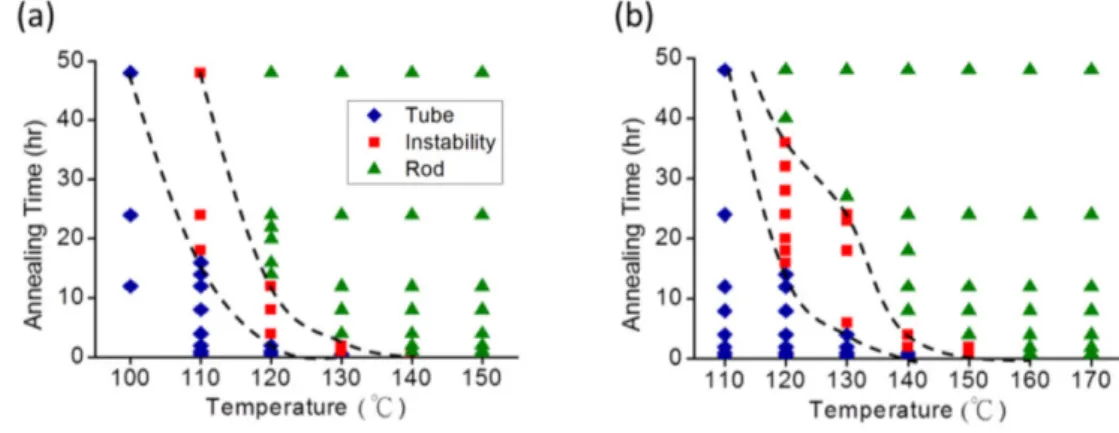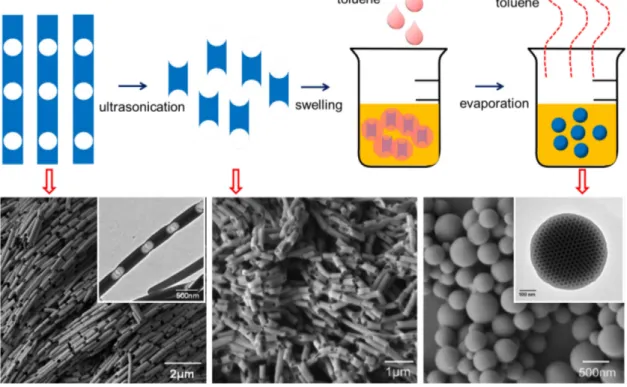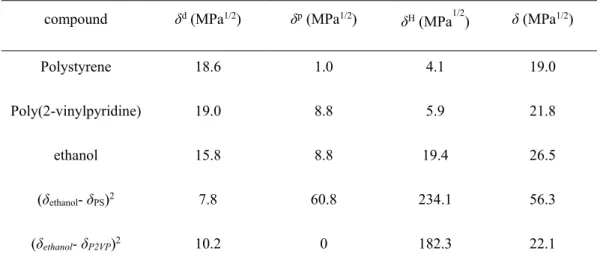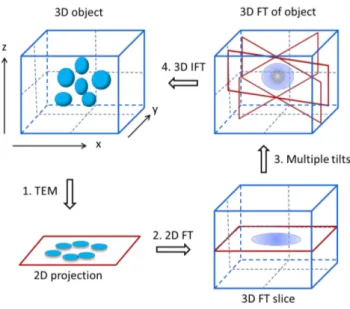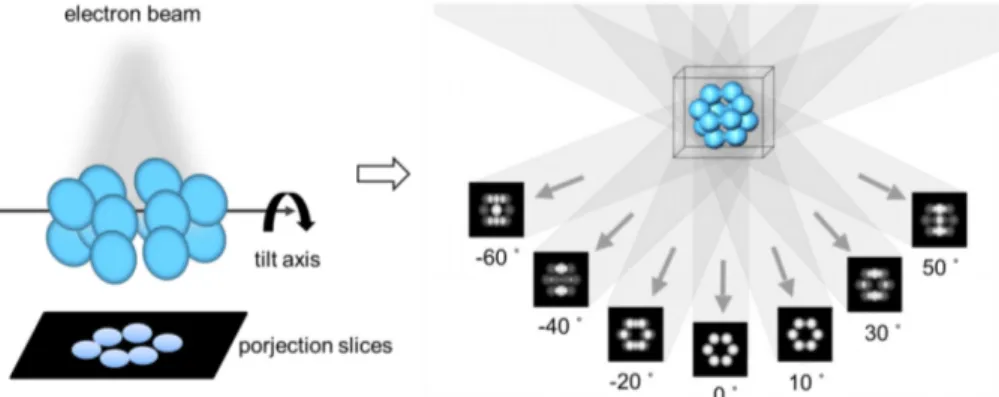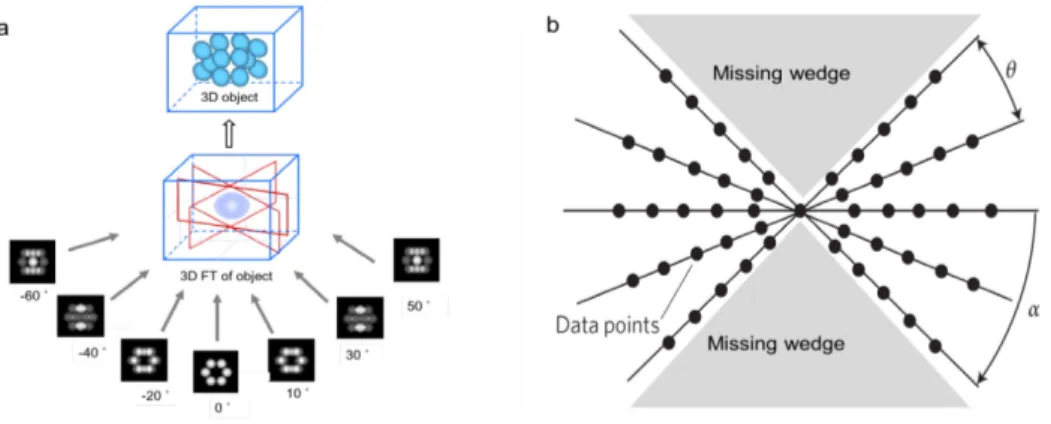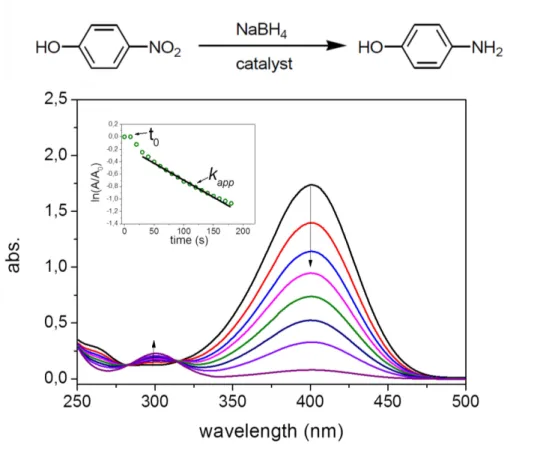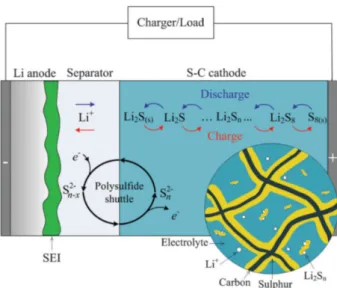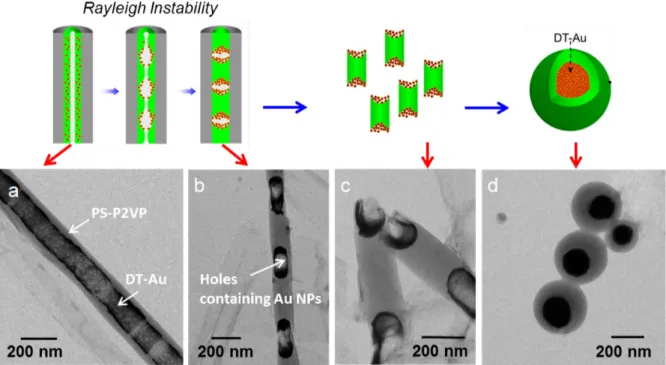functional particles: synthesis, properties and applications
D i s s e r t a t i o n
zur Erlangung des akademischen Grades d o c t o r r e r u m n a t u r a l i u m
(Dr. rer. nat.) im Fach Chemie
eingereicht an der
Mathematisch-Naturwissenschaftlichen Fakultät der Humboldt-Universität zu Berlin
von
M. Sc. Shilin Mei
Präsident der Humboldt-Universität zu Berlin Prof. Dr.-Ing. Dr. Sabine Kunst
Dekan: der Mathematisch-Naturwissenschftlichen Fakultät Prof. Dr. Elmar Kulke
Gutachter: 1. Prof. Dr. Matthias Ballauff 2. Prof. Dr. Nicola Pinna
Tag der mündlichen Prüfung: 25-04-2017
A book is the same today as it always was and it
will never change.
To My Family & Friends
I
The present thesis focuses on the synthesis of novel functional materials by using block copolymer particles as soft templates. Three types of particles with complex structures have been synthesized, involving palladium@poly(styrene-b-2-vinylpyridine)@dodecanethiol-gold (DT-Au) (Pd@PS-P2VP@DT-Au) hybrid particles, polydopamine@gold (PDA@Au) nanoreactors with Au nanoparticles immobilized in PDA channels, and porous Ti4O7 particles with interconnected-pore structure. Their possible applications as catalyst and energy storage materials have been studied.
In the first part of the thesis, Pd@PS-P2VP@DT-Au core-shell particles, which consist of dodecanethiol-gold (DT-Au) aggregation as core and Pd coated PS-P2VP as shell, have been fabricated based on the Rayleigh instability of polymer nanotubes inside Anodic Aluminium Oxide (AAO) porous membranes. The hybrid particles show efficient catalytic activity for the reduction of 4-nitrophenol by NaBH4. The catalytic activity has been compared with other reported systems.
In the second part, PDA@Au nanoreactors with interconnected channel structures have been synthesized for the first time by using porous PS-P2VP particles as soft template. Electron tomography (ET) provides direct visualization of the interconnected pore structure of the nanoreactors, inside of which Au nanoparticles are homogeneously embedded. Such PDA@Au particles have been explored as nanoreactors for kinetic studies using the reduction of 4-nitrophenol as the model reaction.
In the third part, porous Ti4O7 and carbon-coated Ti4O7 particles with interconnected-pore structure have been developed as efficient sulfur-host material for lithium-sulfur batteries by using porous PS-P2VP particles as template. The Ti4O7/S and carbon-coated Ti4O7/S composites show excellent electrochemical performance with initial capacities of 1219 mAh g−1 and 1411 mAh g−1, capacity retentions of 74% and 77% after 200 cycles, respectively.
Keywords: block copolymer, PS-P2VP, metal nanoparticles, polydopamine, catalyst, Ti4O7, lithium-sulfur batteries
II
III
Gegenstand dieser Arbeit ist die Synthese neuer funktioneller Materialien unter Zuhilfenahme von Blockcopolymerpartikeln als „soft templates“ und die Untersuchung ihrer Anwendungsmöglichkeiten als Katalysator- und Energiespeichermaterialien. Drei Arten von Kompositpartikeln mit komplexen Strukturen wurden synthetisiert:
Palladium@poly(styrol-b-2-vinylpyridin)@Dodecanthiol-Gold (Pd@PS-P2VP@DT-Au) Hybridpartikel, Polydopamin@Gold (PDA@Au) Nanoreaktoren und poröse Ti4O7 Partikel mit verbundener Porenstruktur.
Im ersten Teil der Arbeit wurden Pd@PS-P2VP@Au Kern-Schale Partikel, bestehend aus DT-Au Aggregaten als Kern, umgeben von mit Palladium Nanopartikeln beschichtetem PS- P2VP als Schale hergestellt. Die auf die strukturierte P2VP Schale aufgebrachten Palladium Nanopartikel weisen im Vergleich mit anderen bekannten Systemen gute katalytische Eigenschaften für die Reduktion von 4-Nitrophenol mit NaBH4 auf.
Im zweiten Teil wurden zum ersten Mal PDA@Au Nanoreaktoren mit verbundener Porenstruktur unter Verwendung einer „soft template“-Methode synthetisiert. Dabei wurden poröse PS-P2VP Partikel als Template verwendet. Mittels Elektronentomografie (ET) konnte die verbundene Porenstruktur mit den darin gleichmäßig verteilten Gold Nanopartikeln direkt abgebildet werden. Die PDA@Au Partikel wurden mithilfe der katalytischen Reduktion von 4-Nitrophenol kinetisch untersucht.
Im dritten Teil wurden poröse Ti4O7 Partikel mit verbundener Porenstruktur als neuer Typ von Schwefel Wirtsmaterial für Lithium-Schwefel Batterien unter Zuhilfenahme von porösen PS-P2VP Templatpartikeln entwickelt. Die elektrochemische Untersuchung von Ti4O7/S und kohlenstoffbeschichtetem Ti4O7/S beim Einsatz als Kathodenmaterial ergab hervorragende Leistungsdaten von 1219 mAhg−1 bzw. 1411 mAhg−1 für die Anfangskapazität und eine Kapazitätserhaltung von 74% bzw. 77% nach 200 Zyklen.
Stichwörter: Blockcopolymer, PS-P2VP, Metallnanopartikel, Polydopamin, Katalysator, Ti4O7, Lithium-Schwefel Batterien
IV
V
Zusammenfassung ... III
1. Introduction ... 1
1.1 Self-assembly of block copolymers (BCPs) ... 2
1.2 Block copolymer directed assembly of metal nanoparticles ... 5
1.3 Mesoporous materials using block copolymers as template ... 8
1.3.1 Mesoporous polymeric materials ... 8
1.3.2 Mesoporous metal and metal oxide materials ... 10
1.4 Objectives ... 12
2. Theory ... 15
2.1 Formation of block copolymer nanoparticles ... 15
2.1.1 Formation of block copolymer nanospheres based on Rayleigh instability ... 15
2.1.2 Selective swelling induced porous block copolymer nanoparticles ... 19
2.2 Morphology study of the polymer-based nanoparticles by electron tomography ... 22
2.2.1 Electron tomography process: data acquisition ... 23
2.2.2 Electron tomography process: tomographic reconstruction ... 24
2.3 Kinetic study of the reduction of 4-nitrophenol using metal nanoparticles as catalyst .. 26
2.3.1 Catalytic reduction of 4-nitrophenol as model reaction ... 27
2.3.2 Kinetics of the model reaction ... 28
2.4 Metal oxide particles as cathode materials for lithium-sulfur (Li-S) batteries ... 30
2.4.1 Principles of the Lithium-Sulfur (Li-S) batteries ... 30
2.4.2 Technical challenges ... 33
3. Assembly of Palladium (Pd) and Dodecanethiol-gold (DT-Au) nanoparticles onto Poly(styrene-b-2-vinylpyridine) (PS-P2VP) nanospheres with ordered spatial distribution ... 37
3.1 Synthesis of DT-Au nanoparticles ... 39
3.2 Synthesis of PS-P2VP@DT-Au core-shell particles ... 40
3.3 Tunable loading of different amounts of DT-Au nanoparticles ... 42
3.4 The influence of the polymer concentration ... 44
3.5 Optical properties of PS-P2VP@DT-Au particles with different core sizes ... 45
3.6 Decoration of the PS-P2VP@DT-Au core-shell particles with Pd nanoparticles ... 46
3.7 Reduction of 4-nitrophenol using the Pd@PS-P2VP@DT-Au particles as catalyst ... 47
VI
4. Polydopamine@gold (PDA@Au) nanoreactors with interconnected channel structure
... 51
4.1 Preparation of porous PS-P2VP nanoparticles as soft templates ... 53
4.2 In situ growth of Au nanoparticles on PS-P2VP porous templates ... 54
4.3 Generation of PDA@Au nanoreactors ... 54
4.5 Three dimensional (3D) visualization of the PDA@Au particles ... 57
4.6 Kinetic study of the reduction of 4-nitrophenol using PDA@Au particles as catalytic nanoreactors ... 60
4.6.1 Catalytic reduction of 4-nitrophenol in PDA@Au particles nanoreactors ... 60
4.6.2 Theoretic analysis of the surface-controlled reaction model ... 61
4.6.3 Kinetic study of the reduction of 4-nitrophenol in PDA@Au nanoreactors ... 63
5. Porous Ti4O7 particles as cathode material for lithium sulphur battery ... 66
5.1 Formation of porous Ti4O7 nanoparticles ... 69
5.1.1 Influence of the water concentration on the hydrolysis of Titanium isopropoxide . 70 5.1.2 Influence of PS-P2VP template on the porous structure of Ti4O7 particles ... 71
5.2 X-ray diffraction and N2 adsorption/desorption measurements of the Ti4O7 particles .. 73
5.3 Modification of the Ti4O7 particles with a thin layer of carbon ... 75
5.4 The electrochemical performance of Ti4O7/sulphur cathode ... 76
6. Summary ... 83
7. Experimental ... 85
7.1 Chemicals and Materials ... 85
7.2 Synthesis procedure ... 85
7.2.1 Synthesis of Pd@PS-P2VP@DT-Au particles ... 85
7.2.2 Synthesis of PDA@Au nanoreactors ... 87
7.2.3 Synthesis of porous Ti4O7 nanoparticles ... 89
7.3 Characterization ... 91
7.3.1 TEM ... 91
7.3.2 SEM ... 92
7.3.3 Electron tomography and image processing (ET) ... 92
7.3.4 Thermogravimetric Analysis (TGA) ... 92
7.3.5 FT-IR ... 92
7.3.6 XRD ... 93
7.3.7 UV-vis spectroscopy ... 93
7.3.8 N2 adsorption/desorption measurement ... 93
VII
List of Tables ... 117
List of Abbreviations ... 119
Publicaton List ... 123
Acknowledgments ... 125
Selbstständigkeitserklärung ... 127
VIII
1
1. Introduction
Nanomaterials with highly ordered or porous structures are of great interest in a broad range of applications including gas storage and separation materials, encapsulation agents for controlled release of drugs, catalysts, energy storage and sensors.1 The formation of these complex structures usually relies on the availability of templates, which traditionally involve hard templates and soft templates.2, 3 Hard templates are usually solid-state materials with particular structure and morphology. They were popular because of the precise control over size and shape of the resulting materials. However, the removal of hard templates requires harsh conditions, not only complicating the synthesis process, but also causing damage to the degradable materials, which prevent them from further development. On the contrary, soft templates generally consisting of various polymers or surfactants are much easier to be removed by means of simple extraction or evaporation. But the precise control on the morphology of the target product is hard to achieve by using traditional soft templates.
Therefore, combining the advantages of traditional hard templates and soft templates is of great importance for the development of novel functional materials.
Recent advances in this area have demonstrated that block copolymer (BCP) assemblies can fulfill this need, because they can yield ordered structures in a wide range of morphologies.4, 5 Moreover, they are soluble in many organic solvents and can be removed easily by dissolving.
Thus, block copolymer assemblies become promising templates which can realize the precise control on morphology together with the ease of removing. Current studies using block copolymer as template to synthesize advanced materials mainly focus on two directions. One is the assembly of metal/metal oxide nanoparticles into ordered patterns. For example, Jin et al.6 reported the patterned decoration of gold nanoparticles on the surface of poly(styrene-2- vinylpyridine) (PS-P2VP) particles using in situ reduction of HAuCl4 in P2VP domains under UV irradiation. However, most works of this sort focus on the assembly of one type of metal nanoparticles.7-9 No experiment has been conducted on the assembly of two different types of metal nanoparticles to BCP particles with ordered spatial distribution. Integrating specific properties from different materials usually is a practical way to maximize the functionality of the resulted materials. Thus the assembly of different types of metal nanoparticles onto block copolymer nanostructures becomes a subject of great significance.
2
Another direction is creating porous structures through selective etching or selective swelling of the block copolymer materials.10, 11 Block copolymers with one chemically active component have been demonstrated to be promising precursors for the generation of ordered porous structures. For example, Wang et al.9, 10 have studied the swelling-induced pore generation of PS-P2VP or PS-P4VP materials since 2010, they have investigated the porous structures from bulk materials to nanofibers and nanorods. Jin et al.12 extended the porous structures to nanospheres. The corresponding applications have been demonstrated on membrane separation, antireflective coating and drug loading.13, 14 However, the potential application as template for the formation of complex structures has not been extensively studied. Only a few reports present their attempts at exploring the porous bulk materials as templates for functional replicas. No reports have been found about the templating role of the porous particles, whereas nanoparticles with complex inner structures together with designed functional components are of great importance to develop advanced materials. Considering the nondestructive nature of the swelling strategy, the obtained porous particles provide possibilities for the synthesis of a new class of functional replicas with complex inner structures.
Therefore, the present thesis focuses on the synthesis of novel functional materials by using block copolymer nanoparticles and their porous structures as templates. Three works are presented including spatial assembly of two types of metal nanoparticles onto block copolymer nanospheres, synthesis of polydopamine@gold (PDA@Au) nanoreactors, and synthesis of porous Magnéli phase titanium sub-oxides (Ti4O7) nanoparticles. Their possible applications as catalyst and energy storing materials will be discussed in the following chapters.
1.1 Self-assembly of block copolymers (BCPs)
Block copolymers are molecules composed of different blocks covalently connected into one macromolecule. Minimization of free energy during microphase separation can lead to the formation of various thermodynamically-stable structures on nanometer scale.4 With the advent of anionic polymerization, which permits the synthesis of model block copolymers with narrow molecular weight distribution, microphase separation structures of block copolymers containing amorphous blocks have been explored extensively.15, 16 Generally, in
3 Figure 1.1.1 Mean-field phase diagram for model diblock copolymers.4 Phase are labeled L (lamellar), H (hexagonal cylinders), Qla3d (bicontinuous cubic gyroid), Qlm3m (BCC spheres), CPS (close-packed spheres), and DIS (homogeneous). χ : Flory-Huggins interaction parameter; N: the total chain length (or molecular weight);
f : the volume fraction of one block (for diblock copolymers, fA + fB = 1). When χN is small, the system is homogeneous, microphase separation does not take place. If χN is large (≥10), the system spontaneously undergoes microphase separation. The final structure is determined by f. Systems with approximately equal lengths of ‘dislike’ blocks (fA=0.5) form lamellae, while highly asymmetric systems (very small fA) form BCC spheres, with the short block comprising the discrete phase. Cylinders and gyroid structures form between spheres and lamellae. The characteristic spacing is determined by N.
bulk, block copolymers with immiscible blocks can microphase separate as a function of composition into a variety of morphologies: body-centered cubic (BCC) array of spherical domains, hexagonally packed cylinders, bicontinuous gyroid and an alternating lamellar morphology (Figure 1.1.1).4, 17 Because these structures are resulted from block copolymer microphase separation, they are generally called microdomains. The self-assembly process is driven by an unfavorable mixing enthalpy coupled with small mixing entropy, with the covalent bond connecting the blocks preventing macroscopic phase separation.
Different from bulk materials, the microphase separation patterns of block copolymer nanoparticles are strongly affected by the spherical geometry. The spherical confinement
4
Figure 1.1.2 TEM images of PS-PB particles with different ordered structures. (a) onion-like microphase separation structure; (b) helices structure; (c) packed spheres structure.18
differs from that in bulk where the principal curvature is zero. It is a three-dimensional (3D) confinement. Under the efforts of curvature, commensuration (the size of the nanospheres is integral multiple of the microdomains) and surface properties, the microphase patterns are forced to conform the geometry of the nanospheres. There are many theoretical and experimental works investigating block copolymer nanospheres with ordered structures.19-23 Yang’s group18 has systematically studied the microphase separation structures of polystyrene-b-polybutadiene (PS-PB) particles with the volume fraction of PS (fPS) for three different values. They observed that with the decrease of fPS from 0.4 to 0.21 and 0.04, the microdomains of lamellae, cylinders, and spheres were structured in concentric arrangements due to the spherical confinement of the particles. The generated nanostructures changed from onion-like to helices and finally packed spheres structure (Figure 1.1.2).
Apart from the dominating role of the volume fraction of the blocks, other experimental factors such as preparing method, preparing temperature and the size of spherical confinement also have great impact on the nanstructure of block copolymer particles. For example, Yabu et al.24 studied the nanostructures of symmetrical polystyrene-b-polyisoprene (PS-PI) particles prepared using the self-organized precipitation method at various temperatures from 10 to 40
˚C. They observed different microphase separation structures in the nanoparticles, including disordered, stacked lamellar and onion-like structures depending on their preparation temperature (Figure 1.1.3). Besides, the size of the spherical confinement also has influence
Figure 1.1.3 STEM images (dark field) of PS-PI nanoparticles prepared at (a) 10 ˚C, (b) 25 ˚C, and (c) 40 ˚C.
Scale bars indicate 300 nm. (PS-PI: Mn(PS) = 17800 g/mol, Mn(PI) = 12000 g/mol, fPI = 0.43).24
5 Figure 1.1.4 TEM images (dark field) of PS-PB nanoparticles with different sizes of spherical confinement. The confinement is calculated as D/L0. (D: diameter of the particles; L0: the feature spacing of the phase-separated periodic domains) (a) D/L0 = 2.0; (b) D/L0 = 2.5; (c) D/L0 = 3.3; (d) D/L0 = 4.0. Scale bars indicate 50 nm.18
on the morphology of the block copolymer particles. As demonstrated by Yang et al.,18 a small volume of the particles usually contains a few individual microdomains. Whereas a larger volume allows for more repeated microdomains, which can form ordered structures inside the particles.
These nanostructured polymer particles are of great interest due to their possible applications in nanotechnology, for example the applications in nanolithography, fabrication of nanocontainers for drug delivery, and building of photonic crystals.25-27 In addition, block copolymer particles can serve as template for the assembly of metal nanoparticles into ordered patterns.Particles composing of degradable or swellable components offer opportunities for the synthesis of porous structures and even more complex structures. Therefore, block copolymer nanoparticles will be promising candidates to work as templates for the synthesis of complex nanostructures.
1.2 Block copolymer directed assembly of metal nanoparticles
Metal nanoparticles have promising applications in various optical, electronic, and sensor devices because of the extraordinary functionalities that their bulk counterparts do not have.28 When multiple metal nanoparticles are organized at the nanometer scale, collective phenomena can be caused by the interaction among them. This strongly relies on the morphology of the assembly including the configuration of their organization and the interparticle distance.29 For example, depending on the polarization of light, metallic nanoparticles in a one-dimensional linear array exhibit a remarkable difference in absorption spectra owing to their anisotropic configuration.30 Moreover, the size and spacing of the arrayed nanoparticles determine the degree of surface plasmon resonance coupling.31 Robust and feasible techniques to arrange nanoparticles with tunable assembly have been extensively
6
explored in the last few years.32, 33 One such technique is direct-write lithography, which includes electron-beam lithography 31 and dip-pen nanolithography.32 However, conventional lithographic processes show their practical and theoretical limits and make it challenging to arrange nanoparticles with single particle precision. On the contrary, block copolymer directed self-assembly approaches provide opportunities to overcome these limitations, especially to control the inter-particle ordering precisely to tailor the coupling phenomena in nanoparticle clusters.34
Two major strategies have been explored to generate metal nanoparticle arrays within block copolymer microdomains: in situ synthesis of metal nanoparticles, and assembly of surface modified metal nanoparticles into selected block copolymer microdomains.35, 36 The assembly of modified nanoparticles within block copolymers relies on a delicate balance of the interactions between the ligands attached to the nanoparticles and the segments of the block copolymers, as well as the influence of the size of the nanoparticles on the chain configuration of the block copolymers.37, 38 In addition, this method requires the functionalization of nanoparticles surfaces with small molecules or polymer brushes, which increases the complexity of the synthetic process and limits the use of the metal nanoparticles.
For in situ nanoparticle synthesis, a wide range of metal nanoparticles can be assembled into block copolymer nanostructures via reduction of metal precursors, which can be selectively coordinated with one of the blocks. The reducing methods range from chemical reduction to thermal decomposition, vapor deposition, and sputtering.39 In aqueous solutions, metal nanoparticles are typically produced from the chemical reduction of metal ions by reducing agents such as NaBH4, citric acid, or ascorbic acid. Externally supplied energy such as photoirradiation,40 ultrasound irradiation,41 or heating42 can be also applied for the reduction.
Until now a big family of electron donor type block copolymers such as polyvinylpyridine (PVP)-containing polymers have been intensively studied for directing the assembly of metal nanoparticles.43 Owing to the electronegative nitrogen in the pyridine ring, various kinds of metal ions can coordinate with the PVP-containing polymers, which can be further reduced into metal nanoparticles arranged in ordered-patterns. For instance, Buriak and co-workers44 have fabricated catalytic stamps through a two-step procedure, in which linearly arranged Pt nanopattern is produced in the poly(styrene-2-vinylpyridine) (PS-P2VP) template via in situ reduction of H2PtCl4, followed by the transfer of the Pt nanopattern onto the
7 Figure 1.2.1 SEM (a) and AFM (b) images of a Pt mask with line patterns fabricated from PS-P2VP loaded with Pt salt. 44 (c) Schematic illustration and microscopy images of metal hybrid block copolymer (Au@PS- P4VP) microspheres with controlled surface structures.45
poly(dimethylsiloxane) (PDMS) surface through a peel-off approach (Figure 1.2.1a, b). Kim and co-workers45 reported the patterned decoration of gold nanoparticles on the surface of PS- P4VP particles using in situ reduction of HAuCl4 in P4VP domains under UV irradiation (Figure 1.2.1 c).
Most works of this sort have only focused on the assembly of one type metal nanoparticles.46,
47 Multifunctional materials usually require the integration of unique properties of different materials. Due to the limited chemical composition of the block copolymers, few of them exhibit selective preferences to different metal nanoparticles.45 Thus few experiments have been conducted on the assembly of two different types of metal nanoparticles to block copolymer particles with ordered spatial distribution. In addition, there are still technical difficulties in preparing hybrid particles embedded with large amount of metal nanoparticles for practical device applications. Usually the interaction between the high-content metal nanoparticles and their favorable block of the block copolymer will increase its effective volume, resulting in breaking of the ordered structures.43-46 In general, it is critical to control both the distribution and high loading rate of metal nanoparticles within the block copolymer particles.
Fabrication of size tunable polymer particles by swelling the short rod-like entities generated from Rayleigh instability of polymer nanotubes inside the anodic aluminum oxide (AAO) nanopores was reported recently.48 Different from commonly used methods, this strategy allows the injection of hybrid materials such as the mixture of metal nanoparticles/polymer. In consideration of the interactions of the AAO wall with different injected materials, this
8
strategy provides possibilities for the generation of phase separated hybrid nanostructures, which can be promising candidates for the fabrication of BCP particles loaded with different types of metal nanoparticles. In the present thesis, I will study a novel approach for the synthesis of particles selectively loaded with two types of metal nanoparticles.
1.3 Mesoporous materials using block copolymers as template 1.3.1 Mesoporous polymeric materials
Hierarchically porous materials provide synergies between mechanical properties, transport properties, and enhanced surface area.49 Integrating 3D continuous mesopores (diameter of 2~50 nm) with macropores (diameter > 50 nm) is of particular importance in catalytic conversions because it combines high specific surface area with high flux. Potential applications range from catalysis to batteries and bioengineering.49 Among polymeric materials, block copolymer self-assembly is known to generate ordered structures with tunable size and morphology through control over molecular parameters, for instance block component, sequence, and molar mass.50 Specific methods have been developed to form mesopores, including selective etching,51, 52and swelling with sacrificial components.53, 54 The selective etching method mainly takes advantage of the degradable character of block copolymers. Nanoporous polymer materials can be prepared by removal of the constituted components in block copolymers through ozonolysis,55 UV degradation,56 hydrothermal degradation,57 or reactive ion etching.58 Compared with selective etching, another distinct strategy is based on the swelling-induced morphology reconstruction of self-assembled amphiphilic block copolymers without losing any component.53 In this methodology, pore generation is based upon the confined swelling and subsequent drying-induced collapse of separated microdomains of minority blocks. This strategy has been especially valued in recent studies for the reason of preserving their mechanical strength and chemical heterogeneity of the block copolymers. The block copolymers used in this procedure are generally amphiphilic ones with PS as nonswollen majority block, because its Tg is higher than ambient temperature.
Examples include polystyrene-b-poly(2-vinylpyridine) (PS-P2VP), polystyrene-b-poly(4- vinylpyridine) (PS-P4VP), polystyrene-b-poly(acrylic acid) (PS-PAA), polystyrene-b- poly(ethylene oxide) (PS-PEO), poly(styrene-b-methyl methacrylate) (PS-PMMA), polystyrene-b-4-(perfluorooctylpropyloxy)styrene (PS-PFS), and polystyrene-b- poly(perfluorooctylethyl methacrylate) (PS-PFMA).1, 59, 60 The swelling solvents are generally
9 Figure 1.3.1.1 Molecular structures of polystyrene-b-poly(2-vinylpyridine) (PS-P2VP) and polystyrene-b- poly(4-vinylpyridine) (PS-P4VP).
selective solvents for the minority block but not for the PS block, for example, ethanol for the P2VP phase in PS-P2VP, and supercritical CO2 for the PFS phase in PS-PFS.59, 60
The selective swelling of block copolymers for pore generation can occur in nanorods or nanotubes, thin films, and nanoparticles.12, 53, 54 The thin films with spherical or cylindrical domains are used most frequently to create porous structures. Wang et al.61 have intensively investigated the evolution of morphology of PS-P2VP films soaked in ethanol with different temperatures and times, showing various porous structures of the thin films (Figure 1.3.1.2).
Compared with numerous studies on block copolymer thin films, there are only a few reports on the selective swelling of block copolymer nanoparticles. Porous or hollow block copolymer nanospheres with large surface area and internal loading space are of great importance in medical, biological and catalytic studies. The precise control on the pore opening and closing has attracted increasing interests from researchers. For instance, Jin et al.12 put much effort on the investigation of swelling induced mesoporous PS-P2VP nanoparticles. They demonstrated a novel way to tune the pore size and their surface arrangement through a supermolecular assembly process. Besides, they also found a pore closing strategy by swelling the porous particles in good solvent vapour to the PS matrix.
Further modification of the porous block copolymer materials will lead to well-designed functional materials. For example, Abetz et al.62 proposed an approach to functionalize the PS-P4VP membranes with the temperature- and pH-responsive polymer, poly(N- isopropylacrylamide) (pNIPAM)-NH2, leading to a double stimuli-responsive membrane (Figure 1.3.1.2). The modified porous membranes offer promising applications such as molecule separations.
10
Figure 1.3.1.2 (a-i) SEM images of porous PS-P2VP membranes prepared at different swelling temperatures and times. The swelling temperatures of (a-c), (e-f), and (g-i) were 55 ˚C, 65 ˚C, and 75 ˚C, respectively. The swelling times of (a, d, g), (b, e, h), and (c, f, i) were 6 h, 15 h, and 24 h, respectively. The scale bar is 500 nm. 61 (j-l) Double-stimuli responsive membrane obtained from functionalization of porous PS-P4VP template.62
Current works on porous polymer materials are mainly focusing on porous membrane, closed capsules, and particles with open porous structure.54-57 More complex nanostructures, such as porous particles with separated chambers or confining spaces of other shapes, have not been extensively studied due to technical difficulties in synthesis. Moreover, a special class with encapsulated guest species such as metal nanoparticles in the interior, is of great interest as nanoreactors for the study of chemical reactions confined in nano-space. The well-established pore-making strategies of block copolymers provide the possibility of synthesizing the aforementioned complex nanostructures. For example, the selective swelling induced porous materials can be applied as templates, which can not only introduce functional materials to the backbones, but also be removed by dissolving, leading to complex porous and hollow structures. As far as we know, there is no report on the using of porous polymer particles as soft template for the synthesis of more complex nanostructures.
Therefore, this thesis will study the templating effect of porous PS-P2VP particles on the synthesis of polydopamine@gold nanoreactors particles with interconnected pore structure.
1.3.2 Mesoporous metal and metal oxide materials
Compared with porous polymeric materials, metal and metal oxides possess stronger chemical and thermal resistance. Such porous inorganic materials have exceptional properties such as low relative density (ρMNMs/ρbulk), enhanced plasmonic behavior, high strength-to-weight ratio, and size effect-enhanced catalytic behavior.63 These properties are of great interest in many fields of applications including supercapacitors, high-power-density batteries, viable
11 Figure 1.3.2.1 (a-c) Schematic illustration for the preparation of alumina networks of interconnected nanotubes by ALD on swelling-induced mesoporous block copolymer templates. (d) Top view and (e) cross-sectional view of the alumina porous membrane with interconnected tube structure.69
hydrogen storage, and high-efficiency catalysts.64 Porous metal or metal oxides are much more difficult to be fabricated in comparison with porous block copolymer materials. Only a few synthetic pathways have been demonstrated. For instance, by using a bottom-up approach, aerogels with metallic backbones can be obtained from direct assembly of metal nanoparticles into gels via sol-gel process.65 In contrast, by using a top-down approach, nanoporous Au can be prepared via selective removal of Ag from a Au-Ag alloy (a process called dealloying).66 Apart from the conventional methods, recent studies have been focusing on the soft-template method by using porous block copolymer materials as template. A variety of approaches, such as electrochemical deposition,67 electroless plating,68 and atomic layer deposition (ALD)69 have been well demonstrated for the deposition of metal and metal oxides onto block copolymer templates. Among them, atomic layer deposition offers exactly advantages in control of the synthesis at atomic level of metal oxides. The deposition onto interconnected block copolymer network is proved to be a simple strategy to prepare metal oxides with finely adjustable, interconnected pore morphologies. Wang et al.69 have synthesized different porous metal oxides by using porous PS-P4VP membrane obtained from a selective swelling method as template, followed by the replica of different metal oxides involving Al2O3, TiO2, ZnO, V2O5, WO3, MoO3 (Figure 1.3.2.1) through the ALD method.69, 70
12
Different from bulk or membranes, metal oxide nanoparticles can exhibit unique physical and chemical properties due to their limited size and a high density of corner or edge surface sites.71 Although the synthesis of porous metal oxide membranes has been well developed, there are few reports on the synthesis of conductive metal oxide nanoparticles, such as Ti4O7
particles, with interconnected pores in the interior. Such kind of particles can provide polar surface, high conductivity, as well as separated confining spaces, which are highly valued as sulphur host materials for lithium-sulphur (Li-S) battery.72, 73 Unfortunately, technical difficulties are still existing in the synthesis of such kind of porous metal oxide particles. On one hand, the commonly used deposition methods such as electroless plating and atomic layer deposition no longer fit for the nanoparticle templates, which are usually dispersed in aqueous or organic solution. On the other hand, in comparison with 2D membranes, the deposition or growth of metal oxides on the surface of block copolymer nanoparticles are more difficult due to the curvature. Thus, it remains a big challenge to develop a simple and universal method for the synthesis of conductive metal oxide nanoparticles with complex inner structure.
In my study, the swelling induced porous block copolymer particles have been applied as template to direct the deposition of metal oxide precursors (titanium isopropoxide), followed by the hydrolysis and calcination. The block copolymer templates can be removed by calcination, leading to the porous Ti4O7 particles. This thesis will demonstrate the obtained porous Ti4O7 particles can work efficiently as cathode materials for Li-S batteries.
1.4 Objectives
The main objective of this thesis is to synthesize novel functional materials with complex structures by using block copolymer nanoparticles as soft templates. Their possible applications as efficient catalyst and cathode material for Li-S batteries will be investigated.
PS-P2VP particles and their porous structures induced from a selective swelling process have been used as templates.
First, PS-P2VP dense particles with ordered phase-separation structures can be applied to direct the assembly of metal nanoparticles into ordered patterns. The main interest of this work is to assemble two different types of metal nanoparticles onto one polymer particle. The control over the types of metal nanoparticles and their separated spatial distribution is a big challenge that has not been realized before this work. The investigation is carried out as follows:
13
• In order to realize the assembly of Pd and Au nanoparticles onto PS-P2VP nanospheres with separated distribution, a synthesis route has been designed by combining the Rayleigh instability of polymer nanotubes inside AAO membrane with a swelling process in toluene/water emulsion.
• To follow the morphology transformation of the target particles from the beginning, TEM characterization has been applied at different steps of the synthesis procedure.
The influences of the concentrations of PS-P2VP and Au nanoparticles on the morphology of the resulting particles have been studied.
• To study the optical properties of the target particles, UV-vis absorption has been measured for the particles with different core sizes. The catalytic activity of the particles has been investigated with a model reaction, the reduction of 4-nitrophenl by NaBH4.
The second work aims at synthesizing the PDA@Au nanoreactors with interconnected channel structure by using porous PS-P2VP particles obtained from a selective swelling process. The influence of the complex structure on the catalytic reaction of 4-nitrophenol has been studied. The investigation has been conducted as follows:
• In order to generate a new type of nanoreactors with interconnected channel structure, porous PS-P2VP particles obtained from a selective swelling process, which consists of interconnected networks of micellar nanofibers, have been used as templates.
• The control over the thickness of the PDA layer has been studied by tuning the polymerization time. The morphology of the product has been characterized by TEM.
The formation of PDA and Au nanoparticles has been demonstrated by FTIR and XRD spectra.
• To get the 3D structures of the template and the product, a direct visualization method, Electron tomography (ET), has been applied for both the porous PS-P2VP template and the resulted PDA@Au nanoreactors, inside of which Au nanoparticles are embedded separately in the channels.
• Additionally, the full kinetics of the reduction of 4-nitrophenol has been studied by using the PDA@Au particles as catalytic nanoreactors. Different concentrations of 4- nitrophenol and sodium borohydride have been used for the experimental and theoretical study. A comparison has been made between the catalytic system in this work and those reported in literatures, including Au nanoparticles immobilized in spherical polyelectrolyte brush (SPB) and ligand-free Au nanoparticles.
14
The third work aims at synthesizing porous Ti4O7 particles with high surface area and interconnected pores, which can provide both polar surface and valid confining volume for polysulfides in Li-S batteries.
• PS-P2VP templates with different porosities have been applied to generate the Ti4O7
particles. To optimize the experimental conditions, a series of hydrolysis ratios (Ti/H2O molar ratio) have been studied.
• To obtain the Ti4O7 crystal structure, calcination in a tubular furnace at 900 ˚C under Ar atmosphere has been carried out to reduce the insulating TiO2 into Magnéli phase titanium sub-oxides (Ti4O7). To reveal the porous structure of the Ti4O7 particles, SEM, TEM and BET measurements have been conducted on the porous particles. A layer of carbon has further been coated on the surface of the Ti4O7 particles to improve the conductivity of the particles.
• To evaluate the electrochemical properties of the Ti4O7/S and carbon coated Ti4O7/S composite, 2032-type coin cells have been fabricated with thick coated electrode films, in which the mass loading of sulphur has been controlled to be approximately 1.0~1.2 mg per electrode. The CV profiles, rate capabilities and cycling performance have been investigated and compared with the TiO2/S cathode.
15
2. Theory
2.1 Formation of block copolymer nanoparticles
Block copolymer nanoparticles are widely used in various applications in the fields of photonics, electronics, and biotechnology.21 There are many preparation methods for the synthesis of such kind of nanoparticles, including milling of bulk materials, emulsion polymerization, and reprecipitation.74 However, it has not been achieved to combine tunable size of the particles together with highly ordered nanostructure derived from the microphase separation using the aforementioned methods. This is because the size and shape of the polymer precipitates are largely dependent on physical conditions such as the speed of mixing and evaporation. The highly ordered nanostructure is strictly dependent on a narrow distribution of the molecular weight, which is difficult to achieve in emulsion polymerization.
Very recently, a novel synthesis strategy based on the Rayleigh instability of polymer nanotubes confined in anodic aluminum oxide (AAO) nanopores has been reported by Jin et al.48 In the demonstrated model, PS-P2VP particles with tunable size and highly ordered nanostructures can be obtained by using commercial block copolymers with a narrow polydispersity index (PDI) value. In this thesis, these PS-P2VP particles with well-defined morphology have been applied as soft templates for the assembly of metal nanoparticles. In addition, the swelling induced porous PS-P2VP particles have been used as templates for the synthesis of more complex structures, including polydopamine@gold particles and Ti4O7
particles with interconnected porous hierarchy.
2.1.1 Formation of block copolymer nanospheres based on Rayleigh instability
Lord Rayleigh (1878) examined a common experience: a thin jet of liquid is unstable and breaks into droplets.75 When a jet is thin enough, the effect of gravity is negligible compared to surface energy. The jet changes its shape to reduce the total surface energy. This phenomenon is named as the Plateau-Rayleigh instability, often just called the Rayleigh instability.76, 77
The driving force of the Rayleigh instability is that liquids, by virtue of their surface tensions, tend to minimize their surface area. Srolovitz and Safran (1986) gave a simple geometric argument.79 Assume that the surface energy density is isotropic, and the free energy of the
16
Figure 2.1.1.1 Graphical illustration of the Rayleigh instability. A liquid cylinder undulates and transforms into a chain of spheres. (a) Real water flow and (b) graphical model.78
system is the surface area (S) times the surface tension (γ). One has to show that the cylinder has a larger surface area than the row of spheres. Consider a long cylinder with radius R, and a row of droplets with radius b. Imagine that the cylinder evolves to the droplets by first perturb the surface with a wavelength λ. The volume per wavelength of the cylinder equals the volume of each droplet, so that the droplet radius is given by 𝑏𝑏= (3𝜆𝜆𝑅𝑅42)13. The free energy per wavelength of the cylinder is 2𝜋𝜋𝜋𝜋𝜋𝜋𝜋𝜋. The free energy per droplet is 4𝜋𝜋𝑏𝑏2𝜋𝜋. The free energy of cylinder is larger than the row of droplets if 𝜋𝜋 > 9𝑅𝑅2 . From this geometric (energetic) consideration, one can expect that a thin liquid flow will evolve to a row of spheres with large enough radius.
The Rayleigh instabilities also occur when a liquid film is coated onto the wall of a capillary tube. For a thin liquid film with a thickness e, and a tube with a pore radius b, when e « b, the film undergoes an undulation process to minimize the surface energy. As the amplitude of undulation grows with time, crests may merge to form bridges across the capillary tube, producing a rod with periodic encapsulated holes.80-82 The transformation process of polymer nanostructures is shown in Figure 2.1.1.2. There are four states in the transformation process, including (A) nanotubes, (B) undulated structures, (C) Rayleigh-instability-induced structures, and (D) nanorods.
Figure 2.1.1.2 Schematic mechanism of the transformation process by thermally annealing polymer nanotubes confined in the nanopores of AAO templates. The polymer nanotubes (A) are transformed to undulated structures (B), Rayleigh instability-induced structures (C), and finally nanorods (D).78
17 According to the theory of the Rayleigh instability, the relationship between the wavelength of the undulation and the diameter of the cylinder can be shown as the following: 79
𝜋𝜋 = (2𝜋𝜋√2)𝑏𝑏 (1)
This indicates the length of the rod like structures (λ) can be directly controlled by tuning the capillary pore size (b). Theories also predict how fast the structure transformation occurs:
𝜏𝜏𝑀𝑀 = 12𝜂𝜂𝜂𝜂𝛾𝛾𝑒𝑒34 (2)
Where 𝜏𝜏𝑀𝑀 is the characteristic time, η is the viscosity, b is the pore radius, γ is surface tension of liquid, and e is the initial film thickness. According to the formula, 𝜏𝜏𝑀𝑀 is proportional to the viscosity of the liquid. In the case of polymer melt, the viscosity changes with temperature and molecular weight. The morphology diagrams of the transformed structures of polystyrene (PS) at different annealing temperatures and times are constructed based on experiment results, showing the kinetic pathway of the structure transformation.78 From the morphology diagrams (Figure 2.1.1.3), it can be observed that the initial instability structure region occurs at shorter times when the annealing temperature is higher. For example, initial instability PS (Mn = 24 kg/mol) structure region is ∼18 h when the annealing temperature is 110 °C (Figure 2.1.1.3a), which is reduced to ∼1 h when the annealing temperature is increased to 130 °C.
Therefore, the time required to transform from the tube structures to the instability structures at 130 °C is shorter than that at 110 °C. In addition, the instability structure region is larger at lower annealing temperatures. Similar tendency in the morphology diagram can be observed for PS with higher molecular weight (Mn = 100 kg/mol), as shown in Figure 2.1.1.3b.
Figure 2.1.1.3 Morphology diagrams of polymer nanostructures from PS with two different molecular weights:
(a) Mn = 24 kg/mol and (b) Mn = 100 kg/mol. The solid blue diamonds indicate the nanotube structures. The solid red squares indicate the instability structures. The solid green triangles indicate the nanorod structures.78
18
The polymer nanorods with periodic holes are demonstrated to be easily broken during morphology characterizations.83 This inspires Jin et al.48 to cut the nanorods at the weak part to generate nanoblocks with similar length. After swelling in toluene/water emulsion followed by evaporation of toluene, the nanoblocks transformed into nanospheres. A mechanism for the structural transformations induced by swelling-deswelling process has been proposed (Figure 2.1.1.4). Toluene is a good solvent for polymers and is slightly soluble in water. As it diffuses into the polymer blocks, they swell and the solid blocks become liquid droplets.84 The swollen blocks adjust their shapes into spherical droplets in order to minimize the interfacial energy.
Without surfactant, the swollen particles coalesce. When surfactant is present, they remain stable. The toluene can be removed by steam stripping or thermal annealing, which are common methods for removing organic solvents from polymer dispersions.85 Because toluene and water have a large miscibility gap, this procedure removes nearly all the toluene.
Current studies of this sort have only demonstrated the synthesis of pure polymer particles.
The generation of hybrid particles by using the method based on Rayleigh instabilities has not been approved. Wetting the AAO channels with hybrid melt such as the mixture of block copolymer/metal nanoparticles will provide opportunities for the study of the instability of
Figure 2.1.1.4 Synthesis process of polymer nanospheres from short nanorods obtained from Rayleigh instability (upper panel) and corresponding SEM and TEM images of the PS-P2VP nanostructures (lower panel).48
19 heterogeneous phase. The instability and the phase behaviors inside the AAO channels are of great interest, which will greatly affect the morphology of the resulting hybrid particles. The location of the injected metal nanoparticles and their influence on the surface pattern of the resulted hybrid particles are needed to be revealed.
In this thesis, I use the mixture of PS-P2VP/gold nanoparticles for the first time as the wetting materials. The instability of the hybrid melt inside the AAO channels and the morphology of the resulting hybrid particles have been studied. The assembly of a second type of metal nanoparticles onto the hybrid particles is also attempted, aiming at exploring a novel synthesis of multifunctional materials.
2.1.2 Selective swelling induced porous block copolymer nanoparticles 2.1.2.1 Mechanistic understanding of the pore formation process
The selective swelling-induced pore generation process can be described as three steps:
(1) Uptake of the selective solvent (2) Swelling of the minor block (3) Drying by solvent evaporation
We take PS-P2VP as an example. Upon immersion of the block copolymer in ethanol, which is a solvent selective for the PVP phases, ethanol diffuses into the film and is preferentially enriched in the PVP microdomains because of the much stronger affinity of ethanol toward PVP than toward PS. The PVP microdomains are consequently swollen and expanded, leading to the progressive accumulation of osmotic pressure. It was found that the glass transition temperature (Tg) of PS homopolymers was decreased from 100 °C in the dried state to 82 °C when immersed in ethanol,86 revealing the moderate plasticization/swelling effect of ethanol toward PS. Considering that the swelling process is performed at elevated temperatures (typically at 60-75 °C) that are slightly lower than the Tg of PS in ethanol, plastic deformation of the PS matrix will occur, driven by the accumulated osmotic pressure in the PVP microdomains. Upon drying, the swelling PVP chains collapse with the evaporation of ethanol. However, the spaces initially occupied by the expanding PVP microdomains are fixed because the PS matrix accommodating these spaces loses its mobility in the absence of ethanol and a driving force for recovery. Consequently, pores are created in
20
Figure 2.1.2.1.1 Schematic mechanism of the pore formation process. The model polymer is PS-P2VP, the selective solvent is ethanol.
these spaces with the collapsed PVP chains lying along the pore wall (Figure 2.1.2.1.1).
Under stronger swelling conditions, the PVP microdomains are highly swollen. Consequently, the adjacent PVP domains contact and then merge to form a continuous phase of swelling PVP chains, correspondingly resulting in an interconnected porosity in the subsequent drying process. Experiments show that the drying step does not noticeably influence the pore sizes.87 This is because for a given BCP film the pore size is determined by the amount of the swelling solvent taken up by the PVP microdomains. Once the solvent is completely evaporated, the pores will be fixed to the same size regardless of how fast the polymer is dried.
Both block copolymer compositions and swelling conditions, including swelling agents, temperature and duration, influence the swelling behaviors and consequently the morphologies of the obtained porous materials. According to the phase diagram,88 for PS-PVP with PS as the majority block, the PVP phases in the morphology of spheres,89 cylinders, 14 and gyroids91 are suitable to be converted into the nanoporous structures through this swelling mechanism. Therefore, block copolymers with volume fractions (f) of the minority in the 5% - 38% range can be converted to porous structures, while those with f > 38% may be directly dissolved in the selective solvent.
2.1.2.2 Interaction between selective solvents and block copolymers
The morphology of the swollen materials is affected by several factors including the volume fraction of the swollen block, the chemical properties of solvents, and the corresponding block-block and block-solvent χ-parameters (the Flory-Huggins parameter).91 χ can be
21 roughly estimated by analyzing the difference between the solubility parameter (δ) of each component. The solubility parameter can be calculated from the sum of the squares of the Hansen dispersive (d), polar (p), and H-bond (H) components:
𝛿𝛿= �(𝛿𝛿𝑑𝑑)2+ (𝛿𝛿𝑝𝑝)2+ (𝛿𝛿𝐻𝐻)2 (3)
When the solubility parameters of the polymer and the solvent are similar, dissolution of polymer is optimal. As these values diverge, the polymer coils in diluted solutions contract.92,
93 For block copolymers, the solubility of each block in the selective solvent will determine which block is preferentially swollen.
As discussed above, we take PS-P2VP as the model block copolymer. Table 2.1.2.2.1 lists the dispersive (δd), polar (δp) and H-bond (δH) contributions of the single solvent ethanol and two blocks of PS-P2VP. The interaction between the blocks and the solvent can be indicated from the calculated value of (𝛿𝛿𝑠𝑠𝑠𝑠𝑠𝑠𝑠𝑠𝑒𝑒𝑠𝑠𝑠𝑠− 𝛿𝛿𝜂𝜂𝑠𝑠𝑠𝑠𝑏𝑏𝑏𝑏)2 . Relatively larger value indicates poorer interactions. If a solvent mixture is applied, the solubility parameter as well as the porous morphology can be tuned by changing the solvent composition. As shown in table 2.1.2.2.1, compared with PS, P2VP block is more polar and easy forming H-bond with ethanol.
Differences in the solubility parameters are much larger between PS and ethanol than they are between P2VP and ethanol. Experiment results also demonstrate that the PS block almost has no contact with ethanol.87
Table 2.1.2.2.1 Hansen solubility parameter a contributions for the solvent and copolymer blocks, and the interactions between solvent and different blocks.
compound δd (MPa1/2) δp (MPa1/2) δH (MPa1/2) δ (MPa1/2)
Polystyrene 18.6 1.0 4.1 19.0
Poly(2-vinylpyridine) 19.0 8.8 5.9 21.8
ethanol 15.8 8.8 19.4 26.5
(δethanol- δPS)2 7.8 60.8 234.1 56.3
(δethanol- δP2VP)2 10.2 0 182.3 22.1
a C. M. Hansen, Hansen solubility parameters: a user’s handbook, CRC Press, 1999.
22
Porous polymers have been extensively studied with increasing interests, a broad range of applications have been reported in gas storage materials, supports for catalysts, precursors of nanostructured carbon materials, filtration/separation membranes, proton exchange membranes, packing materials in chromatography and in many other fields.1, 94 However, there are very few reports on the using of porous polymers as soft template for the synthesis of more complex nanostructures. Porous structures produced by selective etching usually lose their active component of the block copolymers, resulting in big limitation in the application as soft template. On the contrary, the selective swelling induced porous structures preserve their mechanical strength and chemical heterogeneity of the block copolymers. These materials provide both geometric confinement and active sites for further functionalization, thus can be perceived as potential soft templates for the synthesis of more complex structures.
Therefore, this thesis will study the templating effect of porous PS-P2VP particles on the synthesis of polydopamine@gold nanoreactors and Ti4O7 particles with interconnected porous structure.
2.2 Morphology study of the polymer-based nanoparticles by electron tomography
Deeper research on the polymer-based materials requires specific powerful tools to characterize their properties and complex morphologies. Microphase-separated structures and mesoporous structures are becoming increasingly complicated with advances in precision synthesis. Characterization of such complex morphologies becomes more problematic.
Figure 2.2.1 Reconstructed 3D images of the PAMAM dendrimer in a PEG network (a),95 and 3D structure of a herpes virus (b, c),96 including the layers that make up its shell: as its innermost layer, the capsid (light blue) - a protein shell with icosahedral symmetry - encloses the viral DNA. This layer is surrounded by the so-called tegument (orange), which is enclosed by the envelope (dark blue). Within the envelope, the tegument, a network of various proteins, is arranged asymmetrically around the capsid.
23 Micrographs taken by conventional microscopy, e.g., TEM, are often inconclusive. This makes the interpretation of the accompanying scattering data quite difficult. The conventional microscopes take two-dimensional (2D) (transmitted or surface) images of three-dimensional (3D) objects. The more complicated the morphologies, the less convincing the 2D images become. It is quite natural to develop new microscopes capable of obtaining 3D images.
The development of electron tomographic (ET) method provides a way to determine the 3D architecture.97, 98 Current studies have shown its powerful capability of revealing complex structures such as cells and porous polymer materials (Figure 2.2.1). There is also considerable excitement about the prospect of applying ET method, especially for the analysis of dynamic macromolecular assemblies that are not easily studied by methods such as Scanning electron microscopy (SEM), Transmission electron microscopy (TEM), X-ray crystallography, and NMR spectroscopy.99 In this thesis, ET is applied to investigate the 3D structure of the synthesized porous polydopamine@gold nanoreactors.
2.2.1 Electron tomography process: data acquisition
Electron tomography (ET) is a method for generating 3D images on the basis of multiple 2D projection images of a 3D object, obtained over a wide range of viewing directions (Figure 2.2.1.1).100 The 3D image is generated in a computer by back-projecting each 2D image with appropriate weighting.
Figure 2.2.1.1 Schematic of a tomographic reconstruction in recipical space: (1) acquisition of projecion images;
(2) Fourier transorm; (3) combination of Fourier transform at different tilt-angles, and (4) inverse Fourier transform (IFT) to reconstruction original shape.100
24
Figure 2.2.1.2 Single-tilt axis data acquisition geometry. The specimen is imaged in the microscope by tilting it over a range of typically ± 60 or 70 degrees in small tilt increments. As a result, a set of projection images (tilt series) needed for tomographic reconstruction is collected.102
The principle of ET is the 3D reconstruction of a specimen from a series of projection images taken with a transmission electron microscope. In ET, a single individual sample is introduced in the electron microscope and a series of images (called tilt series) are recorded by tilting the sample around a single-tilt axis at different angles, typically over a tilt range of ± 60 or 70 degrees and at small increments of 1-2 degrees (Figure 2.2.1.2). Typical ET data sets then range from 60 to 280 images. Due to the resolution requirements, the image size typically is 2048 x 2048, 4096 x 4096, or even 8192 x 8192 pixels.
Computer-automated data collection has been crucial for the advent of ET as a structural technique in cellular biology.101 It allows automated tracking, focusing and recording of images under low electron-dose conditions by dividing the maximum tolerable dose over the total number of images. This preserves the specimen from radiation damage. But, as a consequence, the images exhibit a poor signal-to-noise ratio (SNR) around 0.1. During acquisition, the imperfections of the mechanical tilt system and the electron optics produce shifts in the images. The larger component of these shifts is compensated by the automated tracking procedure. However, a more accurate alignment of the images is needed afterwards by computational procedures.
2.2.2 Electron tomography process: tomographic reconstruction
The mathematical principles of tomographic reconstruction are based upon the central section theorem, which states that the Fourier transform (FT) of a 2D projection of a 3D object is a central section of the 3D FT of the object. 102 Therefore, the 3D FT of the specimen can be computed by assembling the 2D FTs of the images in the tilt series, which yields the 3D structure of the specimen by an inverse FT.
25 The standard method for tomographic reconstruction is Weighted Backprojection (WBP), which essentially is equivalent to the Fourier approach just described but working in real space.102 WBP assumes that the projection images represent the amount of mass density encountered by imaging rays. The method simply distributes the known specimen mass present in projection images evenly over computed backprojection rays. This way, the specimen mass is projected back into a reconstruction volume (backprojected, Figure 2.2.2.1a). When this process is repeated for all the projection images in the tilt series, backprojection rays from the different images intersect and reinforce each other at the points where mass is found in the original structure. Therefore, the 3D mass of the specimen is reconstructed from a series of 2D projection images.
The limited tilt range in ET results in a region empty of information in the Fourier space of the 3D reconstruction (missing wedge, Figure 2.2.2.1b). The resolution of the reconstruction is thus anisotropic (direction-dependent). In real space, it produces artefacts as blurring of the spatial features in the beam direction, making some features appear as elongated in that direction (there is a significant loss of resolution in the Z-direction), features oriented perpendicular to the tilt axis tend to fade from view, and others are not resolved at all. A ± 70 tilt range involves that 22% of the information is missing. The use of double-tilt axis acquisition geometry significantly reduces the missing information (down to 7% in the case of
± 70 tilt range). The angular sampling, that is, the interval between successive tilt images, is another point affecting the resolution of the reconstruction. The more projection images, the better the angular sampling, and as a consequence the better the resolution.
Figure 2.2.2.1 Three-dimensional reconstruction from projections. (a) shows that in the backprojection, the images in the tilt-series are projected back into the volume to be reconstructed. (b) shows the missing wedge results from the limited tilt range.102

